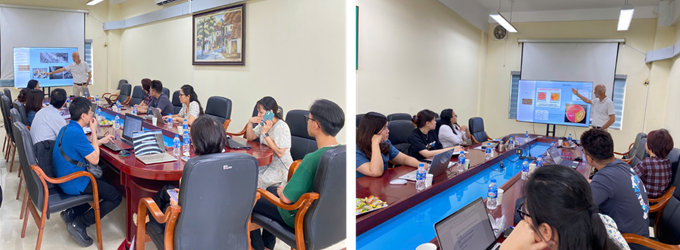On November 12, 2024, during the second working week of Professor Roberto Spurio from the University of Camerino - Italy at the Faculty of Food Technology, Vietnam National University of Agriculture, the research group "Microbiology and Food Safety" invited Professor delivered a seminar on "Staphylococcus aureus: Concepts of Microbiology, Proof of Concept in Production of Novel Antibacterial Compounds" to the "Microbiology and Food Safety" research group, faculty members, researchers, technicians, and interested students.

During the seminar, Professor Roberto Spurio provided information on various topics related to S. aureus and novel antibacterial compounds.
S. aureus, a Gram-positive bacterium, is a significant human pathogen capable of causing a wide range of infections, from mild skin infections to life-threatening conditions like pneumonia and sepsis. Its virulence factors, including toxins, adhesins, and a protective capsule, enable it to evade host defenses and cause disease.
The bacterium is commonly identified through culturing on selective media like mannitol salt agar and confirmed by biochemical tests such as the coagulase test. Understanding the intricate mechanisms of S. aureus infection, including its interactions with the host immune system, is crucial for developing effective therapeutic strategies.
One of the most pressing concerns in S. aureus infections is the emergence of antibiotic resistance, particularly methicillin-resistant S. aureus (MRSA). These resistant strains employ various mechanisms, such as acquiring resistance genes and forming biofilms, to survive antibiotic treatment.
The rise of resistant strains has driven the need for new therapeutic agents. Approaches to discovery include screening natural products from plants, fungi, and bacteria, as well as designing and synthesizing compounds targeting specific bacterial pathways. Additionally, combination therapies may be used to enhance efficacy and reduce resistance.
Vancomycin is a glycopeptide antibiotic primarily used to treat infections caused by Gram-positive bacteria, especially methicillin-resistant Staphylococcus aureus (MRSA). Vancomycin works by inhibiting the synthesis of the bacterial cell wall, preventing the bacteria from growing and reproducing.
Teicoplanin is also a glycopeptide antibiotic, similar to vancomycin, but with a slightly different chemical structure. Teicoplanin is commonly used to treat infections caused by Gram-positive bacteria, including skin and soft tissue infections.
Persister cells are a phenotypic state of S.aureus that allows the bacteria to evade the immune system and cause recurrent infections. They are a small subpopulation of antibiotic-resistant bacteria without genetic mutations. The presence of persister cells partly explains why some infections do not respond well to antibiotics. Even when antibiotics kill the majority of the bacteria, these persister cells can survive and potentially cause a relapse of infection when conditions become favorable again.
Research conducted at the University of Camerino has explored potential natural compounds from various bacterial sources that could inhibit the growth of S. aureus. By extracting culture fluids from both mesophilic and thermophilic bacteria, including hospital strains, researchers have identified promising fractions with antimicrobial activity.

The seminar was a great success, featuring lively exchanges between attendees and Professor Roberto Spurio. In conclusion, the professor emphasized the growing threat of antibiotic resistance, particularly with S. aureus, highlighting the importance of continuing research on novel antibacterial compounds. Through innovative methods in microbiology and drug development, effective strategies can be established to combat this common pathogen. However, it is also necessary to emphasize that the flexibility, adaptability, and mutations of microorganisms make it difficult for the pace of research to keep up.
Research group Microbiology and Food Safety